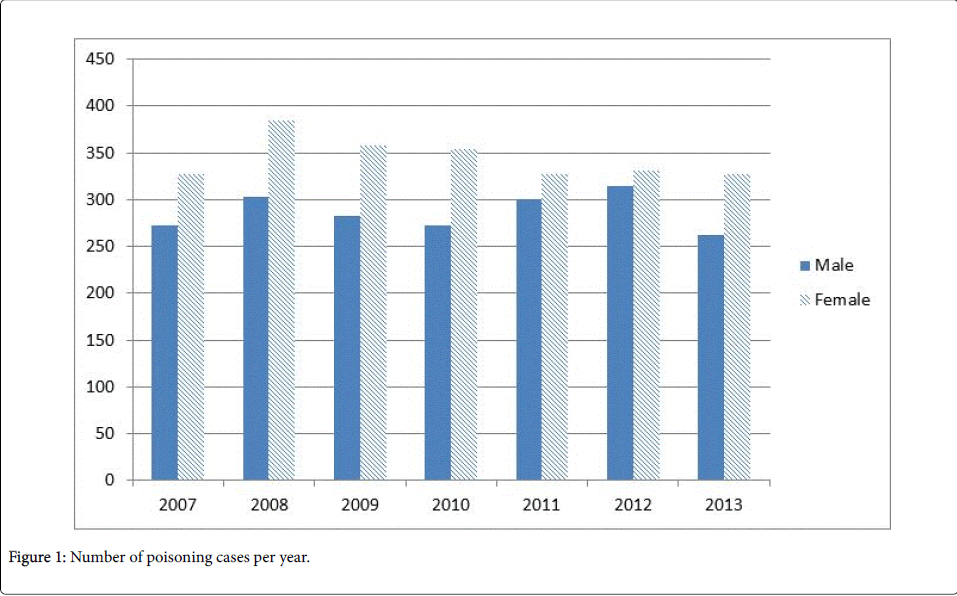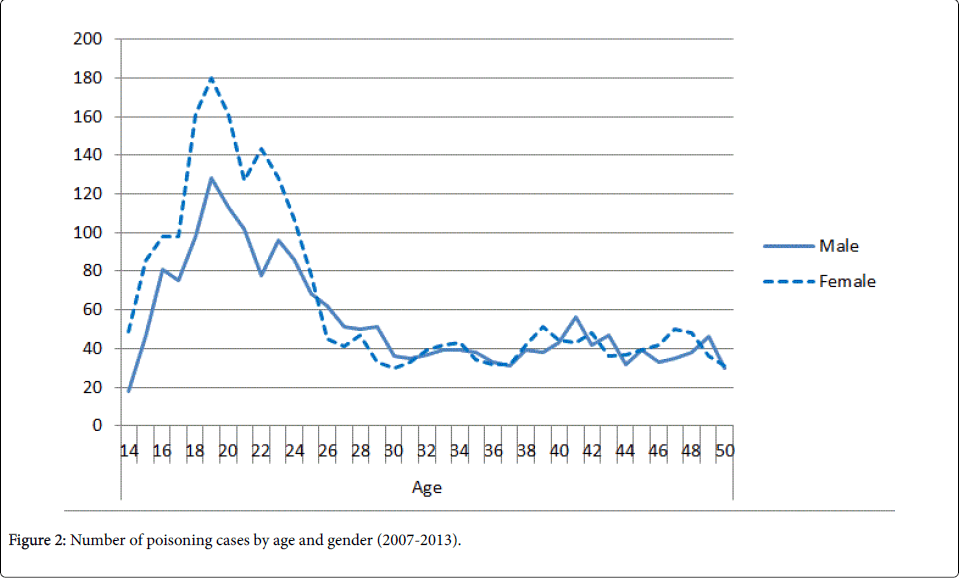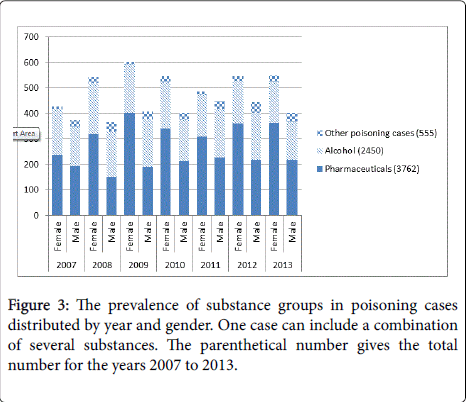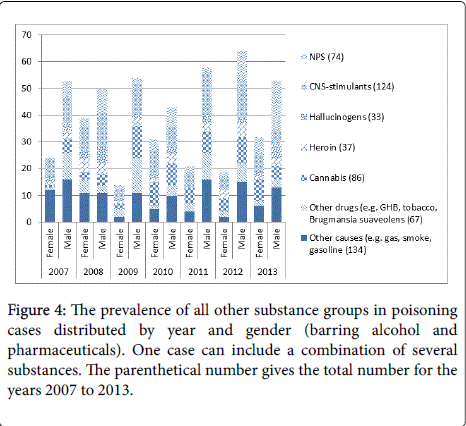Research Article Open Access
Poisoning Casualties: Alcohol, Pharmaceuticals or Legal Highs Poisoning Cases at Emergency Rooms in The Swedish County Vrmland in 2007-2013
Soussan C1, Sundström K2, Andersson M3 and Kjellgren A4*
1Project coordinator, Karlstad University, Sweden
2Public health agent and coordinator for IDB Värmland, Sweden
3Project assistant, Karlstad University, Sweden
4Professor, Karlstad University, Sweden
- *Corresponding Author:
- Anette Kjellgren, PhD
Professor, Centre for Public Safety and Department of Psychology
Karlstad University
SE-651 88 Karlstad, Sweden
Tel: +46 54 700 21 73
E-mail: Anette.Kjellgren@kau.se
Received date: December 05, 2015 Accepted date: December 18, 2015 Published date: December 29, 2015
Citation: Soussan C, Sundström K, Andersson M, Kjellgren A (2015) Poisoning Casualties: Alcohol, Pharmaceuticals or “Legal Highs”? Poisoning Cases at Emergency Rooms in The Swedish County Värmland in 2007-2013. J Community Med Health Educ 5:386. doi: 10.4172/2161-0711.1000386
Copyright: © 2015 Soussan C. This is an open-access article distributed under the terms of the Creative Commons Attribution License, which permits unrestricted use, distribution, and reproduction in any medium, provided the original author and source are credited.
Visit for more related articles at Journal of Community Medicine & Health Education
Abstract
Background: The growing number of novel psychoactive substances (NPS), also labelled as “legal highs”, constitutes a challenge to public health. It is uncertain whether this trend is related to the increase in number of poising cases reported by emergency rooms. The aim of this study was to investigate the occurrence of NPS in acute cases of poisoning in the Swedish county Värmland. The numbers of NPS casualties were correlated with poisoning by other substances. Both, the gender and age distribution of the reported cases were recorded. Method: Records classified as poisoning casualties at the emergency rooms in Värmland during 2007- 2013 were collected and analyzed. Results: NPS and illicit drugs constituted only a small part (1.67% and 7.84% respectively) of the total poisoning casualties. The results also revealed that alcohol and pharmaceuticals were present in the majority of cases (91.2%), and were to a larger extent involved in polydrug abuse and suicide attempts. Furthermore, the results uncovered an alarming poisoning problem among women who had taken pharmaceuticals and for suicidal young people. Conclusions: It is unclear whether the comparatively low prevalence of NPS and illicit drug related poisoning casualties reflect the real prevalence of injury cases or a possible under-reporting.
Background: The growing number of novel psychoactive substances (NPS), also labelled as “legal highs”, constitutes a challenge to public health. It is uncertain whether this trend is related to the increase in number of poising cases reported by emergency rooms. The aim of this study was to investigate the occurrence of NPS in acute cases of poisoning in the Swedish county Värmland. The numbers of NPS casualties were correlated with poisoning by other substances. Both, the gender and age distribution of the reported cases were recorded. Method: Records classified as poisoning casualties at the emergency rooms in Värmland during 2007- 2013 were collected and analyzed. Results: NPS and illicit drugs constituted only a small part (1.67% and 7.84% respectively) of the total poisoning casualties. The results also revealed that alcohol and pharmaceuticals were present in the majority of cases (91.2%), and were to a larger extent involved in polydrug abuse and suicide attempts. Furthermore, the results uncovered an alarming poisoning problem among women who had taken pharmaceuticals and for suicidal young people. Conclusions: It is unclear whether the comparatively low prevalence of NPS and illicit drug related poisoning casualties reflect the real prevalence of injury cases or a possible under-reporting.
Keywords
Poisoning; Emergency room; Legal highs; Novel psychoactive substances
Introduction
Poisoning, including severe side effects of drug use, is a growing and serious health concern in Sweden and elsewhere [1]. Regrettably, there is no comprehensive national statistics on the occurrence of various drug casualties, which is aggravated by the emergence of a great number of novel psychoactive substances (NPS), often called ”legal highs”, with the most part unknown effects and risks [2]. The accelerating development on the market for drugs is confirmed by public statistics, showing that the number of NPS is increasing every year. In the year 2014, 101 new drugs were identified by the EU Early Warning System [3]. In Sweden, various authorities and organizations unanimously reported on the increasing availability of NPS [4-6], as do the media and the scientific literature in headlines referring to poisoning cases from e.g. synthetic cannabinoids (”Spice”) [7].
NPS are often deliberately produced to circumvent current drug legislation while imitating the effects of the corresponding illegal drugs [8]. As soon as an NPS is prohibited yet new and similar substances immediately appears. The ever-changing drug market entails great challenges to legislation as well as to health care and prevention efforts. In addition, scientific knowledge about NPS is extremely limited [9]. The few studies investigating prevalence and casualty rates are often ambiguous because they are based on different populations or substances. For example, a survey of European youth drug habits reported that 5% on average had experience of NPS [10] while a study of nightclub visitors in the UK documented a lifetime experience of 65.8% [11]. An investigation of the situation in Sweden [12] showed that more than 2% of comprehensive school-leavers and 4% of upper secondary students had taken NPS, and no discernibly increasing national trend has been observed despite the growing number of NPS. The reason can be that the NPS proliferation is periodical or regional, as in the case with the substance MDPV, which caused an epidemic like wave of poisoning in the Swedish county of Västmanland in the spring of 2012 [13].
There is a consistent need of documenting the occurrence of NPS poisoning cases to ascertain if the increase of NPS has led to an increase of casualty cases. To this end we analysed data concerning the Swedish county Värmland in the Injury Database (IDB), which contains detailed injury statistics documented by hospital staff in connection with emergency room visits. The quality of the database is considered high, as medically qualified staff performs the coding and registering. The purpose of the record is, according to the National Board of Health and Welfare, to provide detailed injury statistics based on information from outpatient as well as inpatient care for the purpose of injury prevention. Since Värmland as a whole is covered by the IDB record, there is a unique opportunity to investigate the NPS casualty prevalence for a defined population.
The aim of this study was to investigate the occurrence of NPS in acute cases of poisoning in the Swedish county Värmland in the period 2007-2013, and to relate the number of NPS casualties to poisoning by other substances, and to the gender and age distribution of reported cases.
Methods
The IDB record was made available through the existing cooperation between Karlstad University and the County Council of Värmland on injury prevention. In this study, casualty cases classified as poisoning at any of the three emergency rooms in Värmland (Karlstad, Arvika and Torsby) were collected and analysed. The sample was based on individuals, aged 14-50, and comprised casualty cases in the period 2007 – 2013. The IDB data included the variables age, year of injury, municipality, gender and free-text fields providing detailed information of the course of injury.
Analysis of the free-text fields gave rise to two further variables, namely substance/s involved in the course of injury and if attempted suicide was stated. All excerpts from IDB were delivered to us fully anonymised in an Excel-file which was later transferred to the statistic software SPSS for analysis. No personal information or explicit identity markers have been treated. No data from the cause of death record (DOR) have been collected. The study was reviewed and approved by the Research Ethics Committee at Karlstad University (C2014/297).
Results
Poisoning cases in Värmland in general
The total number of reported casualties classified as poisoning at the emergency rooms in Värmland was 4422 in the period studied: 2413 women and 2009 men (Figure 1). The majority of the poisoning cases involved individuals under the age of 26 with a clear overrepresentation of women. The median age was 24 and the highest number of reported casualties happened at the age of 19 for both women (180 cases) and men (128 cases) as presented in Figure 2. Of the 4422 cases, attempted suicide was reported in 977 cases (22.1%). Of these, 346 were men and 631 women. The mode value for suicide attempts was 24 years of age with a clear peak between 18 and 24 years of age.
Causes of poisoning
A clear majority of the poisoning cases involved one or more pharmaceuticals (in 2 572 cases), and/or alcohol (in 2 450 cases). In the 3 922 cases where named substances were stated, there were 56.1% incidents of only one substance, 25.8% of a combination of two substances, and the remaining 18.1% involved combinations of three to ten substances.
The remaining 500 cases consisted of unnamed pharmaceuticals (371 cases) or unspecified agents (129 cases). The most frequent pharmaceuticals were found in the groups with the ATC code N05- Neuroleptics, sedatives and sleeping pills (53.9%), N02-Analgetics (18.5%) and N06-Psychoanaleptics (17.5%). In the period, the majority of cases of poisoning among women involved pharmaceuticals (64.4%) while alcohol occurred in 51.6% of the cases. For men, the situation was the reverse: alcohol was the most common substance (59.9%) and pharmaceuticals occurred in 50.7% of the cases (Figure 3). Other cases of poisoning, including all other drugs and agents (555 cases) are presented in Figure 4. Here we can see that poisoning agents involving smoke, gases and petrol etc. are the most prevalent causes of poisoning (134 cases), closely followed by poisoning in which central stimulants were a contributing factor (124 cases). In falling order the following substances were given as causes: cannabis (86 cases), other drugs such as GHB, Brugmansia suaveolens or tobacco (67 cases), heroin (37 cases) and hallucinogens (33 cases).
The Figure 4 also shows that, during the whole period, men are more represented than women in the category “other poisoning cases”, that is, cases not involving alcohol and pharmaceuticals.
There were local variations of poisoning substance indicating that alcohol, for instance, was most frequent in the municipalities of Sunne and Torsby, while pharmaceutical poisoning was most common in Forshaga and Grums.
There were local variations of poisoning substance indicating that alcohol, for instance, was most frequent in the municipalities of Sunne and Torsby, while pharmaceutical poisoning was most common in Forshaga and Grums.
NPS poisoning cases
The number of casualty cases involving NPS was 74, that is, 1.67% of the total numbers of cases (4 422) in the period. The most frequently reported NPS were the group of synthetic cannabinoids, so called ”Spice” products (28 cases), and different instances of NPS central stimulants (18 cases); next came the substance phenazepam (10 cases). In eleven cases an unspecified “legal high” was reported. A complete list of occurring NPS is presented in Table 1. The municipalities of Grums, Säffle, Arvika and Karlstad had, in falling order, the most cases involving NPS both in relation to population size as well as to the total number of casualty cases.
| Spice | Synthetic cannabinoid | 28 |
| Phenazepam | Sedative | 10 |
| MDPV | CNS-stimulant | 6 |
| Methoxetamin | Dissociative | 3 |
| Ethylphenidate | CNS-stimulant | 3 |
| mCPP | CNS-stimulant | 2 |
| Mephedrone | CNS-stimulant | 2 |
| 3-MMC | CNS-stimulant | 1 |
| N-Ethyl-2C-B | Hallucinogens | 1 |
| PCP-analog | Dissociative | 1 |
| bk-MDMA | CNS-stimulant | 1 |
| MDAA | CNS-stimulant | 1 |
| Methylone | CNS-stimulant | 1 |
| DXM | Dissociative | 1 |
| Bromo Dragonfly | Hallucinogens | 1 |
| Pentedrone | CNS-stimulant | 1 |
| Unknown NPS | 11 | |
| Total for the period 2007-2013 | 74 | |
Table 1: Frequency of NPS reported in the study. The names and abbreviations are stated as they appeared in IDB.
Three quarters (74.3%) of NPS poisoning cases occurred in men and the rest in women (25.7%). A majority of the 74 NPS-related poisoning cases was in the ages of 16 –29 (61 cases) with a peak at ages 21-23 (27 cases). The remaining 13 cases were spread across the sample group till age 50. Among 46 cases of the NPS poisonings (62.2%) no additional substance had been used. In two of the 74 cases of NPS poisoning (2.8%), there was a pronounced suicide purpose, which can be related to the alcohol cases (15.8%) and 36.1% for pharmaceutical poisoning. In one of the two suicide cases involving NPS, phenazepam had been taken while in the other case a combination of methoxetamine and alcohol was used.
Discussion
In contrast to recent media reports of incidents with “legal highs”, the result shows that NPS constituted a small part of the total poisoning problem in Värmland; only 1.67% of the cases were in any way linked to NPS in the period in question. Also the number of poisoning cases involving illegal drugs was generally low (7.84%). Instead, alcohol and pharmaceuticals had been used in a considerable majority of poisoning cases (91.2%), and these were also to a greater extent linked to polydrug use and suicide attempts. The result also indicated an alarming poisoning pattern among women who had taken pharmaceuticals and for suicidal young people.
In view of recent media reports, public authority statistics [3] and the scientific literature [7] on the number of new drugs, their accessibility, low prices and imminent risks; it is notable that more incidents have not been reported. One suggested explanation is that NPS and other illegal drugs are under-identified in the injury statistics [14]. Furthermore, the prevalence rate of drug-related injury cases is known to be lower when the statistics build on self-reports, as in the case of IDB, in contrast to blood or urine analysis [15]. It has also been documented that individuals under the influence of NPS-induced medical conditions have turned to online drug discussion forums for help instead of emergency rooms [16]. The factors above indicate that drug users tend to avoid emergency health care or abstain from stating the cause of the poisoning for fear of social stigmatisation or legal consequences (consumption of illicit drugs is illegal in Sweden). On the other hand, an NPS drug is not prohibited under any law (as illegal drugs), which partly eliminates the incentive to avoid emergency rooms.
In addition, the number of NPS cases in Värmland appears credible if the number is related to the 103 NPS cases reported in a year by emergency rooms in the whole of Sweden. This statement is based on the outcome of a research project conducted to investigate NPS trends nationally [17]. The few NPS poisoning cases in Värmland can be explained by a comparatively limited spread in the region or by the absence of epidemic-like outbreaks previously documented in other areas of Sweden [13]. There is, in other words uncertainty as to whether the number of NPS and drug related poisoning cases reflect the real prevalence of injury cases. However, it is worth mentioning that NPS was the most common cause of poisoning among the drugs in the category “other poisoning cases” in 2013. It indicates that the development of the NPS situation needs to be monitored thoroughly in the future, in particular regarding the growing number of NPS on the international market. Nevertheless, based on the results of the present study, NPS can for the moment be considered to constitute only a minor cause of poisoning casualties.
Our results are full in agreement with the previous reports describing that NPS drugs are mainly used by young men [17]. Most of the poisoning cases were found in the 21-23 age group, which is slightly higher age than for the poisoning cases in general, which was 19. Casualty cases of NPS did occur in all ages up to 50, which indicate that NPS use/abuse is not restricted to be just a youth phenomenon. The low prevalence of suicide attempts in combination with NPS indicates that the new drugs primarily are used for experimental purposes. Our findings are substantiated by an earlier study on NPS indicating that the sensation seeking individuals use novel drugs for their experiences regardless of apparent risks [18].
The most common NPS in casualty cases were different synthetic cannabinoids (”Spice”), CNS stimulating substances and the benzodiazepine phenazepam, which was no surprising since synthetic cannabinoids and CNS stimulants are the most popular groups of NPS (e.g. 2, 7). The knowledge of NPS-related risks and effects, particularly regarding benzodiazepines, is still low and each poisoning case can contribute valuable information. Apart from a research focus on the substances with most health risks (alcohol and pharmaceuticals), suicide attempts and young women’s poisoning problems considerable preventable measures need to be introduced. It is also necessary to keep monitoring the NPS situation. It is further suggested that clinical NPS cases should be documented for research purposes and publication, because the phenomenon has great concern both nationally and internationally. Such knowledge is not only important for adequate treatment of acute poisoning cases but can also support the future drug prevention and injury minimisation efforts.
Acknowledgements
The authors wish to acknowledge the Public Health Agency of Sweden, which supported the present study with unrestricted grants. Also thanks to Elisabeth Wennö for proof-reading of the manuscript.
References
- Schyllander J (2014) Förgiftningar, en översikt [Poisonings, on overview].Report, Karlstad: Myndigheten för samhällsskydd och beredskap [Swedish Civil Contingencies Agency].
- Zawilska JB (2015) “Legal highs” – An emerging epidemic of novelpsychoactive sustances. Int Rev Neurobiol 120: 273-300.
- European Monitoring Centre for Drugs and Drug Addiction (EMCDDA)(2015) New psychoactive substances in Europe. An update from the EU Early Warning System.
- Centralförbundet för alkohol- och narkotikaupplysning (CAN) [TheSwedish Council for Information on Alcohol and Other Drugs] (2013) Droger på nätet [Drugs on the Internet].
- Tullverket [Swedish Customs] (2013) Drogsituationen i Sverige 2010–2012
- Giftinformationscentralen (GIC) [Swedish Poisons Information Centre](2014) Nya missbruksmedel och Internetdroger [New Drugs of Abuse and Internet drugs]
- Salani DA, Zdanowicz MM (2015) Synthetic cannabinoids: the dangers ofspicing it up. J Psychosoc Nurs Ment Health Serv 53: 36-43.
- Johnson LA, Johnson RL, Portier R (2013) Current “legal highs”. J EmergMed 44: 1108–1115.
- Giftinformationscentralen (GIC) [Swedish Poisons Information Centre](2014) Årsrapport 2013.
- The Gallup Organization (Eurobarometer) (2011) Youth attitudes ondrugs. Flash Eurobarometer 330 analytical report. Luxembourg: European Commission.
- Wood DM, Hunter L, Measham F, Dargan PI (2012) Limited use of novelpsychoactive substances in South London nightclubs. QJM 105: 959–964.
- Centralförbundet för alkohol- och narkotikaupplysning (CAN) [TheSwedish Council for Information on Alcohol and Other Drugs] (2014) Skolelevers drogvanor 2014 [Alcohol and Drug Use Among Students 2014].
- Lindeman E, Hultén P, Ström S, Enlund M, Al-Saffar Y, et al. (2012) Ökatmissbruk av internetdrogen MDPV i Västmanland [Increased abuse of the Internet drug MDPV in the county of Västmanland in Sweden]. Läkartidningen 109: 1954-1957.
- Hohmann N, Mikus G, Czock D´(2014) Effects and Risks Associatedwith Novel Psychoactive Substances. Dtsch Arztebl Int 111: 139-147.
- Vitale S, van de Mheen D (2006) Illicit drug use and injuries: A review ofemergency room studies. Drug and Alcohol Dependence 82: 1-9.
- Soussan C, Kjellgren A (2014) Harm-reduction and knowledge exchange A qualitative analysis of drug related Internet discussion forums. Harm Reduction Journal 11: 1-9.
- Helander A, Beck O, Hägerkvist R, Hultén P (2013). Identification ofnovel psychoactive drug use in Sweden based on laboratory analysis – initial experiences from the STRIDA project. Scandinavian Journal of Clinical & Laboratory Investigation 73: 400-406.
- Soussan C, Kjellgren A (2015) “Chasing the High” – Experiences ofEthylphenidate as Described on International Internet Forums. Substance Abuse: Research and Treatment 9: 9-16.
Relevant Topics
- Addiction
- Adolescence
- Children Care
- Communicable Diseases
- Community Occupational Medicine
- Disorders and Treatments
- Education
- Infections
- Mental Health Education
- Mortality Rate
- Nutrition Education
- Occupational Therapy Education
- Population Health
- Prevalence
- Sexual Violence
- Social & Preventive Medicine
- Women's Healthcare
Recommended Journals
Article Tools
Article Usage
- Total views: 10689
- [From(publication date):
December-2015 - Apr 18, 2025] - Breakdown by view type
- HTML page views : 9908
- PDF downloads : 781




